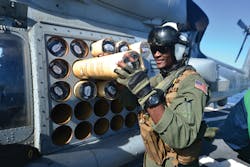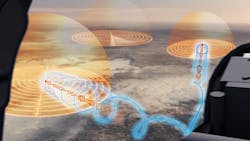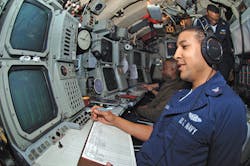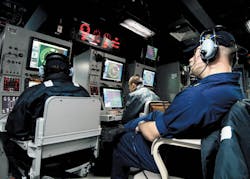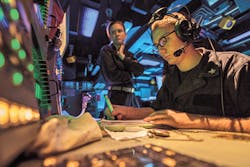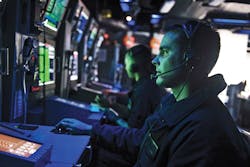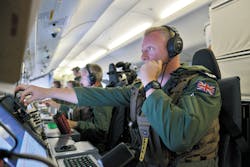Digital signal processing as well as advanced RF and microwave technologies are blending with system automation and machine intelligence to create radar and sonar systems that are more effective than ever before.
BY J.R. Wilson
Although radar first was explored in the late 1800s, this RF sensor technology did not become a vital part of military operations until World War II. The term radio detection and ranging (radar), in fact, first was coined by the U.S. Signal Corps in 1939 during its work for the U.S. Navy. As its name suggests, radar transmits radio waves through the air and watches for any of these radio waves that bounce off aircraft or other airborne targets.
Sonar, short for sound navigation and ranging, can trace its origin to Leonardo da Vinci's 1490 experiments listening to a tube inserted in the water to detect sounds generated by boats. More active efforts at depth sounding and echo ranging came following the sinking of the Titanic in 1912. Anti-submarine warfare during World War I spurred development, but useful active and passive sonars were a product of World War II in the 1940s.
Active sonar seeks to detect objects in the water by transmitting sounds from transducers through the water and listening for the echo when these sounds bounce off marine objects operating on or below the surface of the water. Passive sonar, on the other hand, simply involves sophisticated hydrophones that listen for telltale sounds of ships and submarines. Passive is the more popular method because it doesn't give away the user's presence.
Radar and active sonar can present disadvantages to their users because of their transmitted RF energy and sound signals, which an enemy can detect. These sensor methods are like shining a flashlight in a dark room: They can reveal targets, but tip the enemy off to their presence.
For this reason, submarines rarely have employed active sonar. Once a submarine pings active, the enemy knows he's there, and this is anathema to the submarine's core mission, which is to remain as stealthy as possible.
The more common users of active sonar are surface ships, and even these vessels still ping an active sonar signal only briefly to minimize the risk of detection. Perhaps the most common user of active sonar are sonobuoys dropped by helicopters and fixed-wing aircraft. These air-dropped sonar sensors don't have to remain stealthy; once they're deployed, the enemy knows he's being hunted.
The fast pace of technology over the past two decades enabled development of a new form of radar and sonar that is neither all-active nor all-passive. It's called adaptive radar and adaptive sonar, which can automatically select RF waveforms and processing filters in real time, based on the mission and changing environmental conditions and target countermeasures.
Adaptive radar and sonar
Adaptive radar and sonar systems reach out and touch the environment in which they are operating, and change their signals and digital signal processing for the best ways of finding their targets and remaining as stealthy as possible.
"We've had adaptive processing systems for many decades, but adaptive radar processing - real-time adapting of radar waveforms - has really picked up in the past decade through a number of enabling technologies, such as AESA [active electronically scanned array]," explains Garrett Hennessey, engineering manager for radar systems at the Harris Corp. Radar and Reconnaissance Systems segment in Palm Bay, Fla.
Today's state-of-the-art adaptive radar and sonar capitalize not only on enabling technologies like AESA, back-end software control, and processing, but also on enabling technologies for multifunction systems that blend communications, electronic warfare (EW), detection and tracking, and weather forecasting, Hennessey says. "The multifunction systems use adaptive waveforms, software-defined, that enable multi-mission capability by having an RF front-end that supports wide bandwidths and real-time control while the software back-ends define the mission - radar, communications, EW," he says.
That also applies to adaptive sonar, says Jim Brunelle, manager of the Harris Corp. Undersea Systems segment in Palm Bay, Fla. "You want to adapt your processing to what is going on in the environment as it changes so you have better adaptability. We're not trying to spoof or jam, just adjust to what is happening, in real time, so you can focus on frequencies of interest. These sonars are operating in an environment where you need to get rid of contamination by your own ship's noise and other things in the area you know of. You also have all kinds of different background noise."
Accounting for the operating environment in radar, sonar, and signal processing can help reduce or eliminate sensor clutter and false alarms, Brunelle says. "By adapting to the environment in the way you approach processing, you tend to eliminate clutter and false alarms and present a better-defined, clearer picture to the operators or to the algorithms using that information."
In essence, adaptive radar and sonar helps system operators focus on targets of interest, and ignore irrelevant objects, Brunelle says. "An adaptive approach implements several methods to minimize the effects of things happening in the general vicinity so you can focus in on what you're really interested in finding," he says. "That means not only implementing signal processing and adapting the perimeters that drive those based on the characteristics of the noise environment, but also other approaches that allow conditions to be monitored in real-time and recognize items of interest in certain regions of the frequency spectrum."
Benefits of SWaP
Functions that would have required several digital signal processing embedded computing boards a decade ago are being done now with single-board, high-speed servers today, resulting in substantially more processing power within the same footprint, along with reduced heat generation, both important in a shipboard environment.
As recently as the 1980s, data collection was done on the ship, but processed off-board because the size, power requirements, and heat generated exceeded ship capacity. With major improvements in size, weight and power consumption (SWaP) in recent years, everything now can be done onboard and in real time.
"Advances have gone from a single, mechanically steered sensor and pure audio, with the bulk of the processing between the operator's ears, to advanced, distributed, networked multiple sensors that basically do all the processing," says Charles Lundrigan, chief engineer at Harris Undersea Systems. "Track level information then goes to the combat management system [CMS], which fuses it with radar and electro-optical tracks, intelligence reports, etc., and comes up with a synoptic picture that is shared by the combat management team."
"Improvements in processing power have had a significant impact," Brunelle adds. "We can render data to the operator using color as visual aids and integrating updates based on time-factored presentations. In the old days, you saw a trace on a scope and then it was gone. Today, an operator can work through different display presentations and drill down through those to get a better idea of what do to. That also gives you more time to react to threats."
Among the benefits of enhanced processing power are ease of use for sonar and radar operators, Brunelle says. "It's like any evolving technology: Customers want better detection ranges, more simplified operations so the operators don't have to be as experienced or worry about how to set something up as opposed to what the system can do autonomously, and, of course, more cheaply. So we are continuously driven to find more cost-effective equipment and methods of doing things, plus building systems that are upwardly compatible with evolving technology. But it's critical for the U.S. to maintain superiority in the ability to monitor the environment and react to it."
For decades, sonar operators were trained to listen to returning signals and correlate a visual on a sonar scope and how to set up the system to obtain a more effective end result. Greater automation and in-system processing makes fewer demands on operator judgment. Systems automatically push information to operators, who no longer must make assessments based on raw audio and visual blips.
Systems automation
"All these technology advances have enabled us to move from just looking at signals and noise to detections and alerts and tracks, so we're now at a very high point in the hierarchy so the sonar operator can get real information that lets him do his job better," Lundrigan says. "We're finding, internationally and domestically, that sonar proficiency is a perishable skill and there was a period when giving the operator a high degree of control worked against him because there was just too much information available."
The answer to the problem of operator overload has been system automation. "Now the emphasis is on automating the technology, letting him operate at a higher level while the sonar does the grunt work," Lundrigan says. "Adaptive methods help us do that. The natural path is to make the signal, display, and data processing more automatic, eventually to the point where you don't need a sonar operator. The system reports tracks to the CMS, and the CMS operator, in natural language, can ask the sonar why it thinks the track is real."
Cognitive radar
Future forms of adaptive radar are sometimes referred to as cognitive radar, as described in a paper published in the February 2015 issue of IEEE Transactions on Signal Processing and written by Anish Turlapaty, a postdoctoral research associate, and Yuanwei Jin, an associate professor of electrical engineering, in the Department of Engineering and Aviation Sciences at the University of Maryland.
"Cognitive radar is an emerging technology that aims to explore a higher level of sensing adaptation and biologically inspired intelligence for modern radar design, Turlapaty and Jin wrote. "It is generally believed that a cognitive radar comprises the processes of feedback, learning, information preservation, and adaptability in transmission. It adapts its transmission waveforms, radar beams, and other electronic data processing capabilities in order to achieve superior performance in detection, estimation and tracking by exploiting various knowledge sources."
As with any military technology, advances in capability spur the development of more advanced countermeasures. Given efforts in adaptive radar and sonar systems by other nations, including potential future adversaries, the U.S. is pursuing ways to thwart them. One major effort is the Adaptive Radar Countermeasures (ARC) program of the U.S. Defense Advanced Research Projects Agency (DARPA) in Arlington, Va.
According to DARPA researchers, current airborne electronic warfare (EW) systems first must identify a threat radar to determine the appropriate preprogrammed electronic countermeasure (ECM) technique. This approach loses effectiveness as radars evolve from fixed analog systems to programmable digital variants with unknown behaviors and agile waveforms. Future radars likely will present an even greater challenge as they will be capable of sensing the environment and adapting transmissions and signal processing to maximize performance and mitigate interference effects.
"The goal of the ARC program is to enable U.S. airborne EW systems to automatically generate effective countermeasures against new, unknown, and adaptive radars in real time in the field," the Agency's program description explains. ARC technology will:
- isolate unknown radar signals in the presence of other hostile, friendly and neutral signals;
- deduce the threat posed by that radar;
- synthesize and transmit countermeasure signals to achieve a desired effect on the threat radar; and
- assess the effectiveness of countermeasures based on over-the-air observable threat behaviors.
"ARC technologies will be developed using an open architecture to allow for insertion, modification, and removal of software modules with minimal effect on other elements of the system," DARPA officials say. "ARC algorithms and signal processing software will be suitable for new EW systems and for retrofitting into existing EW systems without extensive rework of front-end, radio-frequency hardware."
Machine intelligence
U.S. and allied EW aircraft typically carry out missions using a library of profiles to counter known adversary capabilities to jam their radar, but advances in software-defined, reprogrammable systems have made that method obsolete.
As adversary radars continue to move away from analog systems to rapidly evolving programmable digital variants with agile waveforms and unknown behaviors, solutions that cannot be developed in theater, in real time, are useless. Moreover, they threaten the safety and mission of U.S. and allied warfighters.
In a speech to the Atlantic Council in May 2016, DARPA Director Arati Prabhakar described the threat, as well as DARPA's efforts to counter it with adaptive radar and ARC. "[Aircraft are] getting pinged by radar signals that we've never encountered before and it's just one reflection of how rapidly technology is changing in the world," she told the Council. "When that happens today, it can be weeks to months to literally years before they're able to get the kind of protection they need against that new radio signal.
"What's needed is an EW system that can detect and analyze new signals, and come up with ways to jam those signals in real time. Machine learning and cognitive EW scan the radio spectrum in real time to determine what the adversary's radar is doing and then, right there on the spot, create a jamming profile that will protect those aircraft in real time in the battle space even when the world around them is changing," Prabhakar says.
In November 2016, DARPA extended an existing ARC contract with the BAE Systems Electronic Systems segment in Merrimack, N.H., designed to enable airborne EW systems to counter new, unknown, and adaptive radars in real time. BAE is completing algorithm development for the program's third phase, advance readiness testing, and milestones for moving ARC technologies to fifth- generation fighter jets.
"In Phase 2, we demonstrated the ability to characterize and adaptively counter advanced threats in a closed-loop test environment. We will now continue to mature the technology and test it against the most advanced radars in the U.S. inventory in order to transition this important technology to the war- fighter," says BAE Program Manager Louis Trebaol.
The goal is to counter the limitations of current systems that were built to deal with a more static, less dynamic, and less ambiguous environment. By relying on a database of known threats with predefined countermeasures, current EW systems are severely limited in terms of adapting to new and advanced threats in theater in real time. Conducting successful missions in future anti-access and area denial (A2/AD) environments will require the ability to isolate previously unknown hostile radar signals in dense electromagnetic environments, then rapidly generate effective countermeasures.
Optimizing resources
"Adaptive systems dynamically optimize their resources to efficiently meet mission requirements, selecting waveforms and operational parameters to fit the mission at hand. If you had a system that was non-adaptive, say an airborne search radar, you would have to use maximum power for the radar at all times; an adaptive system can maintain that track without using more power than needed," says Harris's Hennessey.
"Another important part is being able to align the search volume to where the aircraft is going and not necessarily where it is pointing. If you have a cue coming from another sensor, on- or off-board, an adaptive system can point the radar at that position rather than having to search for it," Hennessey says. "Adaptive systems also are able to increase the probability of detection by directing more RF energy on targets or tracks, increasing update rates. So if you have a particular threat you want to watch more closely, an adaptive system can direct more resources at that threat specifically than a non-adaptive system could do."
The ARC program's cognitive EW technologies, which DARPA began pioneering in 2010, are being developed to deal with anti-access and area denial environments using advanced signal processing, intelligent algorithms, and machine learning techniques as part of an evolution of adaptive and cognitive EW facing increasingly more agile, complex, and adaptable threats in real time. The next major ARC milestone is a planned 2018 flight demonstration.
Other military research labs also are working to advance adaptive radar technology and countermeasures. In May 2016, the U.S. Air Force Research Laboratory (AFRL) at Wright-Patterson Air Force Base, Ohio, issued a contract to Information Systems Laboratories (ISL) Inc. in San Diego to develop an advanced modeling and simulation capability for fully adaptive radar.
"Due to onerous requirements imposed by anti-access/area denial environments, it is imperative to develop innovative signal and data processing techniques for delivering sophisticated sensing capabilities to the warfighter," according to the program solicitation. "Modeling and simulation plays a critical role for fully adaptive radar due to the need for real-time generation of representative scenarios from the standpoint of capturing the dynamically varying statistical and spectral properties of the environment."
Enabling technologies like gallium nitride (GaN), which matured as a commercial off-the-shelf (COTS) capability from the commercial telecommunications industry; gallium arsenide (GaAs) and GaN semiconductors; scalable planar array tiles; advanced field-programmable gate arrays (FPGAs); adaptive beamforming techniques; system-on-chip (SoC); and advances in adaptive beamforming are aiding in the development and fielding of more advanced adaptive radars and sonars.
While it is difficult to determine who has the lead in developing and fielding adaptive radars and sonars, many nations - friend and foe - are known to be putting considerable resources into them. One of the most active - at least publicly - is China.
Technology from China
In 2016 alone, adaptive radar and sonar development efforts came from researchers at the Science & Technology on Sonar Laboratory at Hangzhou Applied Acoustics Research Institute, the Key Laboratory of Radar Imaging & Microwave Photonics at Nanjing University of Aeronautics & Astronautics, the School of Information & Electronics at Beijing Institute of Technology, the Science & Technology on Underwater Acoustic Antagonizing Laboratory in Shanghai, the Shanghai Marine Electronic Equipment Research Institute, Xidian University, Harbin Engineering University, and the University of Electronic Science & Technology of China, among others.
Current forms of adaptive radar and sonar rely on the evolution of enabling technologies, including possible disruptive technologies, which will play an even greater role in advancing adaptive systems.
"The two main enabling technologies have been the RF front-ends and the back-end processors, FPGAs and analog converters, that are getting faster and more powerful every day," Harris's Hennessey says. "Electronically scanned systems have been around for decades, but the enabling technologies - phase shifters and real-time software control - today allow them to be used in other types of systems. The phased arrays themselves have been enabled through gallium arsenide and gallium nitride solid-state modules that have allowed the use of shared apertures to perform multiple functions."
As to the future, Hennessey predicts a continued RF convergence, an overlap of all RF functions and efficient use of the RF spectrum for radar, EW, and communications, while cognitive systems will allow more efficient control.
"When you start to integrate multiple functions, you need efficient algorithms and processors on the back end. Artificial intelligence will play a big role in that," Hennessey continues. "Other enabling technologies on the RF front-end would include continued materials advances, greater efficiencies in SWaP, certainly advances in COTS processors will continue and provide the platforms to run on, with more processing able to be done on the collected data. We're really in the infancy of adaptive radar, as these enabling technologies give systems designers more options.
"Software will play a bigger part, with more RF componentry replaced by software back-ends. Advanced signal processing techniques will allow the back-ends to analyze data in a more thorough fashion and more efficiently adapt the radar to the needs at hand," Hennessey continues. "Adaptive systems will continue to converge, performing multiple RF functions. The technologies of radar, communications, and EW are common across those different classes of sensors, so in the future it is really the software back-ends and efficient management of the RF front-ends that will provide advantages in the military."
